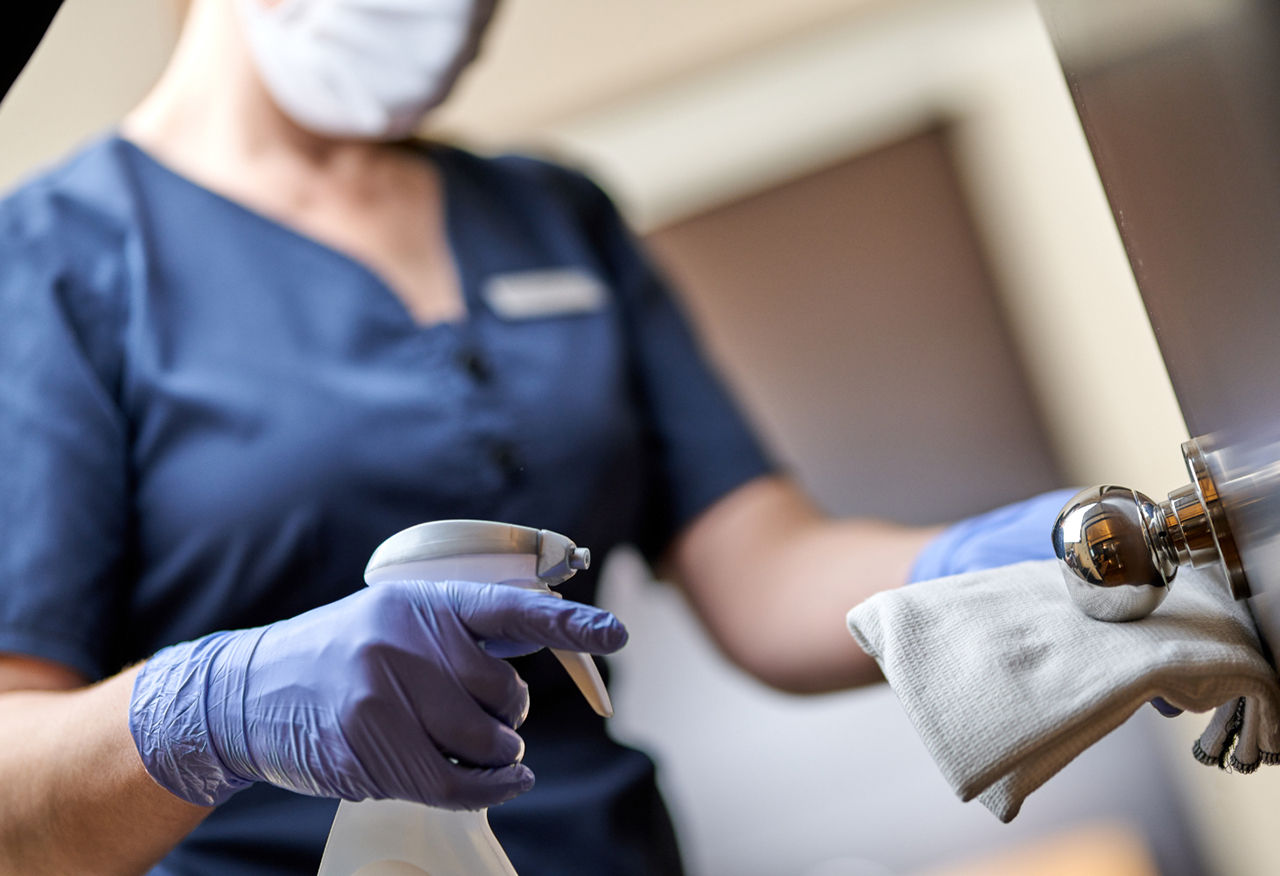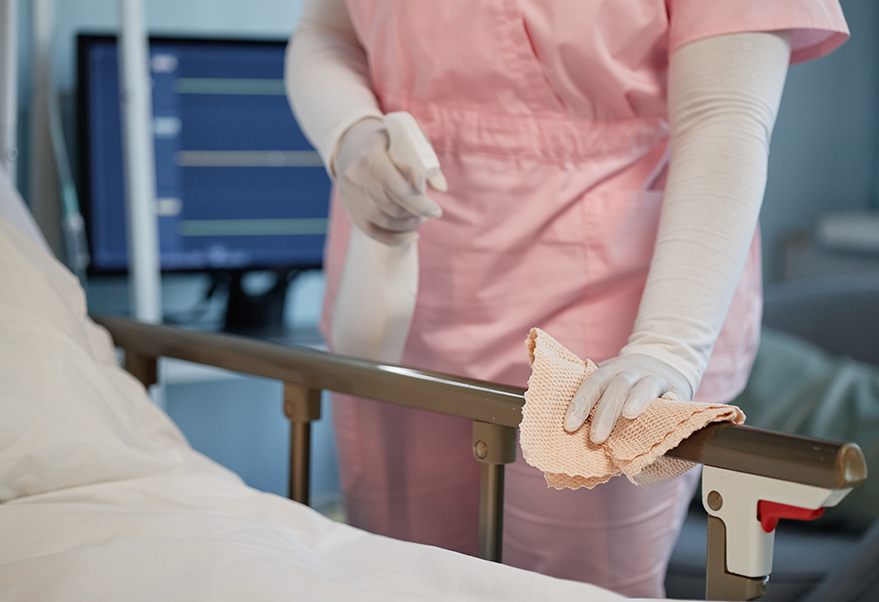Hospital disinfection protocols: best practices and compliance
Maintaining the highest level of safety in healthcare facilities is more than just a routine - it's the cornerstone of patient safety and trust. Effective hospital disinfection protects against healthcare-associated infections (HAIs), ensures regulatory compliance, and builds confidence among patients and staff.
In this article, we'll explore the protocols, the types of disinfectants used in hospitals, and the key considerations for achieving disinfected environments. that as an extension of infection prevention.

Why do hospital disinfection protocols matter?
Hospitals are complex environments where the risk of pathogen transmission is constant. To effectively combat this, a multi-faceted approach to infection control is crucial. It's not just about surfaces; the prevention of microbial spread depends on a comprehensive strategy that includes rigorous hand hygiene, thorough decontamination of medical equipment, and systematic disinfection of all surfaces. This three-pronged approach is essential for breaking the chain of infections, as emphasized by leading health authorities, and is directly linked to reducing infection risks and improving patient outcomes.
What essential questions should I ask when choosing a hospital disinfectant?
Choosing the right disinfectant for healthcare facilities is a critical decision that must take into account a range of criteria beyond just the price.
The first and most important factor is the disinfectant's effectiveness, which is tied to its spectrum of activity (e.g., bactericidal, virucidal, fungicidal) and the required contact time on the surface to achieve the desired biocidal effect.
Equally important is the disinfectant's material compatibility, meaning it must be safe for the surfaces and equipment being disinfected to prevent costly damage. It should also be remembered that cleaning and disinfection are two separate processes: the effective action of a disinfectant is only possible on a clean surface. For this reason, many products combine both cleaning and disinfecting properties, which is particularly practical and time-saving. In such cases, they can act as a disinfectant cleaner.
Finally, the product's regulatory status is crucial. You must ensure that the product is registered in accordance with relevant regional regulations, such as the EU's Biocidal Products Regulation (BPR) and Medical Device Regulation (MDR) or the UK's GB BPR and UK MDR 2002. This confirms its safety, declared effectiveness, and legal use.
How does a disinfectant actually work?
Understanding how a disinfectant works is essential for selecting the right products for your needs. Most disinfectants eliminate or inactivate microorganisms by disrupting their cell walls, damaging proteins, or interfering with metabolic processes. Depending on the chemical formulation and the type of microbe (e.g., spore-forming or non-spore-forming bacteria), they may act within seconds or require a longer contact time.
Different agents provide targeted effectiveness. Here are the application performance criteria you should be aware of:
- Low-level disinfectants: designed to manage microbes that are easy to deactivate, such as gram-positive and gram-negative bacteria, yeasts, and enveloped viruses.
- Mid-level disinfectants: dedicated to hard-to-kill pathogens, including mycobacteria, non-enveloped viruses, and fungi.
- High-level disinfectants: required for special challenges like bacterial spores, which are the hardest microorganisms to kill. In these cases, facilities often rely on a strong disinfectant with proven sporicidal activity.
What are the different types of disinfection in a hospital?
Hospitals perform several types of disinfection to maintain safe environment. Understanding these procedures helps teams balance patient safety with operational efficiency.
- Routine disinfection: This is the standard, daily cleaning and disinfection of all patient areas, staff offices, and common spaces. Its purpose is to reduce the everyday microbial load on surfaces.
- Terminal disinfection: This is a comprehensive cleaning and disinfection of a patient room and its contents after the patient has been discharged, transferred, or has passed away. The goal is to eliminate all pathogens and prepare the room for the next patient.
- Concurrent disinfection: This refers to the ongoing disinfection of surfaces and equipment while a patient is still in the room. It includes tasks like wiping down bedrails and IV poles after each use or quickly disinfecting spills of bodily fluids.
- High-touch surface disinfection: This is a targeted approach that focuses on frequently touched surfaces that are most likely to transmit pathogens. Examples include disinfection of doorknobs, light switches, elevator buttons, call bells, and remote controls.
- Sporicidal disinfection: This is a more advance type of disinfection used to eliminate hard to kill bacterial spores, such as C. difficile. It requires specific disinfectants and a longer contact time.
- Emergency disinfection: This procedure is performed in response to a significant spill of blood or other potentially infectious materials. It involves a rapid and thorough disinfection of the affected area to prevent an outbreak.
What different disinfectant products should we use?
In healthcare settings, various disinfectant formats are used to match the specific needs of different areas and tasks.
- Ready-to-use products (RTUs): These are pre-diluted disinfectant solutions, such as liquids and sprays, that can be applied directly to surfaces without any preparation. They are convenient and save time, making them ideal for quick-turnover areas or for smaller, frequently touched surfaces. Many of these formats include a spray disinfectant option for fast application.
- Disinfectant wipes: Pre-saturated wipes are another popular form of ready-to-use product. They are perfect for quickly disinfecting small medical devices, keyboards, or high-touch surfaces because they are convenient and ensure a consistent application of the disinfectant.
What active substances are used in hospital disinfectants?
The disinfectants used in hospital environments must comply with strict health and safety standards. There is no single universal agent for all applications; each substance differs in its microbicidal spectrum, speed of action, material compatibility (e.g., risk of corrosion), and safety profile for staff and patients. Key categories include:
- Alcohol-based disinfectant liquids: Effective against bacteria and many viruses, ideal for quick disinfection. They usually have limited material compatibility on plastics and lack of cleaning properties.
- Sodium hypochlorite compounds: Traditional, widely used, and effective, but may be corrosive, and there have been reports of their negative impact on the health and well-being of hospital staff.
- Quaternary ammonium compounds (QACs): These provide strong effectiveness against a broad spectrum of microbes. Good material compatibility and cleaning properties.
- Hydrogen peroxide: Known for being highly effective across many applications.
- Chlorine Dioxide-based disinfectants: Their mode of action allow them to be effective against a wide range of microorganisms, including bacterial spores.
This is why it is so important in a medical environment to select the right product for a specific application and surface.
Understanding the 'Hospital-Grade' standard: what you need to know
The concept of a "hospital-grade disinfectant" is not a uniform global standard but a designation that varies depending on regional regulations.
In the European Union, compliance is legally framed within the Biocidal Products Regulation (BPR) and, for some products, the Medical Device Regulation (MDR). In the UK, this is handled by the GB Biocidal Products Regulation (GB BPR) and the UK Medical Devices Regulations 2002 (UK MDR 2002), which are the independent national equivalents.
In addition to these regulatory requirements, disinfectants must also comply with harmonized EN (European Norm) standards. These standards define the specific lab tests a product must pass to prove its effectiveness, covering everything from general bactericidal activity (EN 13727) to specific virucidal activity (EN 14476). (We write more about EN standards in our article: Raising the Bar: Understanding the New Standards for Disinfectant Efficacy in Healthcare)
Healthcare facilities should always verify that products have the necessary official approvals and registrations for their region. This is the only way to safeguard patients and effectively prevent and control the spread of infections.
Best practices for hospital disinfection
Implementing effective hospital disinfection practices requires a combination of staff training, product choice, and standardized procedures. Here are some of the most critical best practices:
- Establish clear cleaning and disinfection schedules that staff can easily follow.
- Use hospital-grade wipes or ready-to-use liquids for quick disinfection of frequently touched areas.
- Apply disinfectant correctly, ensuring proper contact time as specified on the label. This can include spray, wipe, or liquid application methods.
- Train healthcare workers on the difference between cleaning, disinfecting, and sterilizing.
- Reinforce good hand hygiene practices alongside surface and instrument disinfection protocols.
- Monitor product claims based on EN standards to ensure they meet your facility's needs.
How do we make disinfection protocols more effective and sustainable?
Modern hospitals are increasingly focused on both patient outcomes and operational efficiency. That's why it is so important to pay close attention to hygiene product selection.
Disinfectants should have proven efficacy levels dependent on their application (e.g., sporicidal products for final disinfection of heat-sensitive devices or surfaces in the case of C. difficile contamination). They must have the appropriate regulatory status, broad material compatibility, and a strong safety profile for users and patients. Choosing the right products isn't just a matter of compliance; it's a strategic decision that leads to better results.
Final thoughts
Effective hospital disinfection requires a holistic approach. It’s more than just buying a product; it’s about understanding the regulations, the science, and the specific needs of your facility. By using appropriate, hospital-grade disinfectants that are proven to be effective and safe, you can protect patients, empower your staff, and reinforce your commitment to a safer healthcare environment.
Looking to enhance your hospital's disinfection strategy or expand your disinfectants portfolio?
Contact our experts today: hygiene@arxada.com
Don't gamble with your company's future. Choose certainty and security with Arxada.
Want to learn more?




